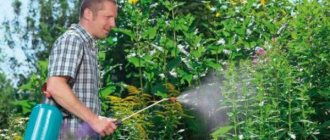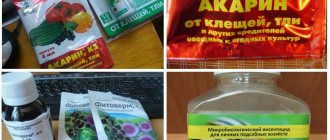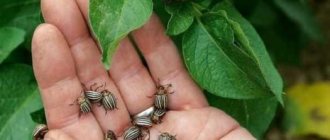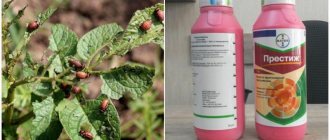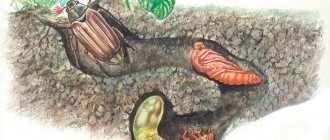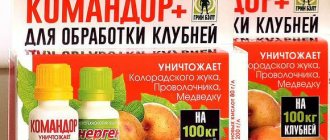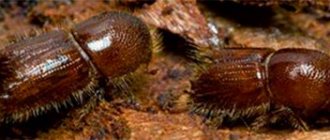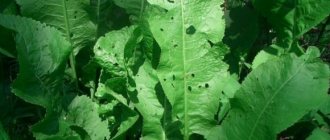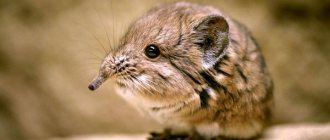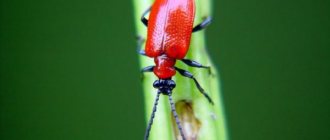Are Colorado potato beetle larvae dangerous for potatoes and other nightshade crops? When to start fighting larvae and adult pests. Advice for summer residents and gardeners. How to save the harvest without harming yourself and the environment. Enemies of the Colorado potato beetle in the natural environment. Agrotechnical measures.
The Colorado potato beetle is known to many summer residents and gardeners, as well as to those who have at least once encountered growing potatoes in their own plots. The invasion of such pests is a real disaster. The Colorado potato beetle larva and adults are quite voracious. They can reproduce quickly.
The induced properties enable them to eat the potato bush in the shortest possible time. If parasites are detected, you cannot hesitate; their urgent elimination is required to save the crop. Below we will look at basic information, life cycle features and ways to deal with Colorado representatives.
Description
Adult individuals differ in the following sizes: length - 1 centimeter, width - 0.65 centimeters. The body has a round-oval, convex shape. The color is yellow-orange, with a glossy surface, there are black dots on the body.
The dorsum is also characterized by the presence of black spots; the elytra are distinguished by five thin black stripes. The porches are developed, making it possible to fly over distances.
If we talk about the larvae, they are also characterized by a convex body shape, but soft, their size does not exceed 1.5 centimeters. Initially they are yellow in color, but over time they darken, acquiring an orange-red or brown tone.
The color changes due to the fact that when consuming the planting leaves, the larva cannot digest the carotene contained in them. The result is the accumulation of carotene in tissues and a change in shade. The head is painted black, on the side of the body there are 2 rows with black dots.
Adult members of the family have a good appetite, and the larvae are even more voracious. Each of them feeds on food from nightshade crops. Most often they are interested in potatoes and eggplants.
But plants such as:
- Tomatoes;
- Physalis;
- Tobacco;
- Bell pepper.
Damage caused
Unlike adult specimens, their larvae are the most gluttonous. Under comfortable weather conditions, their development proceeds at a rapid pace. Moreover, the number of eggs increases tens of times.
If you do not fight the pest, then in just a few days the potato bushes may be left without green mass. As a result, tubers do not form and the plant dies. In order to grow not only a quantitative, but also a high-quality crop, one should not neglect methods of prevention and timely treatment of bushes in case of damage to them by parasitic individuals.
Features of the larvae
Those who have ever encountered growing potatoes know very well that the maximum danger to them comes not from adult insects, but from voracious larvae. They eat not only potato plants, but also plants that belong to the Solanaceae family (tomato, eggplant, tobacco, garden petunia, etc.).
The larva is not at all similar to the adult representatives of the colony. The back is characterized by the shape of a curved crescent, the belly is slimy, swollen, and slightly flattened in the middle. They have a large body (about 1.5 centimeters) of an orange-red hue. As the insect matures, it changes shade, turning orange with black dots, which are located in two rows on the side of the body (more details in the picture).
Young larvae consume the lower part of the vegetation, but over time they make their way to the top, devouring not only shoots, but also leaves, and then move on to plantings located in the neighborhood. You can see what such individuals look like in the photo.
If we describe the lifestyle of Colorado potato beetles, it is worth noting the following stages:
- In the autumn, the female hibernates, and with the onset of spring she wakes up and begins laying eggs on young nightshade bushes.
- After two to three weeks, the eggs hatch into larvae.
- The passage of four stages of development of the larva - all of them are characterized by different shades and end with molting: during the first phase, the body has a gray-yellow color and is covered with thick hairs; it consumes the most tender parts of the pulp of the leaves of the plant as food; during the second phase, the body loses part of the hair, the shade changes to red-orange, it already eats the coarser parts of the leaves, leaving only veins of them; at the third stage, the body acquires a brick color and reaches a size of 1 centimeter; in the fourth phase, the individual acquires a yellow-red color and develops up to 1.5 centimeters.
- Gaining strength, the larvae go underground, where the pupation process occurs. It is here that the pupa is transformed into an insect, which has a body length of up to 12 mm, and the surface of the body is very hard.
- If the transformation takes place before the winter period, the colorados fall asleep and come out with the onset of the first warm days.
Pupation process
When moving into the ground, the larva pupates in the second week. In the soil it is located at a depth of 10-15 cm. At this stage, the insect is least dangerous for the plant; it stays underground for 2.5-3 weeks and does not touch vegetable crops.
The newly formed pupa has a reddish tint, gradually becoming whitish-yellow. Its size at this stage is not inferior to that of an adult Colorado potato beetle (1 cm – length, 0.5 cm – width).
Wintering - how and where
Many people are interested in how long Colorado potato beetles live. Most often, this period is about one year; some of the representatives can live up to three years of age. For the winter, adult pests hide in the ground (burrow deep into the soil to a depth of about 50 centimeters) and spend the entire winter there. If the soil contains a large amount of sand, then they can be buried to a depth of a meter. Cold is not a problem for these parasites; they can withstand temperatures down to -10 degrees.
When the earth warms up and the air temperature reaches 10-15 degrees above zero, pests crawl out and begin to spoil potato plantings and other garden crops.
Throughout its life cycle, when unfavorable conditions occur (for example, drought), the parasite of this family can hibernate.
How did you arrive in the Russian Federation?
Where did Colorado potato beetles come from in Russia? In summer, winds often blow in an easterly direction. The Colorado potato beetle also took this into account. He set off to the East from European countries and already in the 40s crossed the border of the Soviet Union. First of all, the insect attacked Ukrainian fields. A few years later he was noticed in Kaliningrad and Brest.
In 1958, Transcarpathia was struck by an influx of Colorado potato beetles, and Lithuania, to which the pests moved from Poland, did not escape the scourge. The beetle did not stop there and went for a walk around the Union.
He reached Russia in 1975 - a potato lover was brought by freight train in straw from the Ukrainian side. The Southern Urals came under “bombing”, and then the spread began throughout the country.
See below for a description and photo of the Colorado potato beetle.
How to deal with Colorado potato beetles in your garden plot
As we already know, Colorado insects are very voracious insects, especially the larvae - they can eat every leaf of a bush, and in a short period of time.
Vegetation without leaves is not capable of normal growth and development, not to mention obtaining a good harvest of tubers. Most often, such plants are doomed to death. Because of this, when parasites appear, immediate control is required.
Achieving success and the desired result in such a difficult task is possible only by applying an integrated approach, including several methods of struggle.
Among the main methods that allow you to counteract beetles are:
- Manual collection of adult representatives, eggs, larvae;
- Use of natural enemies of pests;
- Use of folk recipes;
- Use of biological agents;
- Purchase of pesticides;
- Implementation of agrotechnical measures aimed at exterminating bugs;
- Planting vegetation that repels parasites;
- Planting a resistant variety;
- Using a trap;
- Installation of repellent devices.
Who brought the dangerous pest to Russia?
Now no one will say where exactly the Colorado potato beetle came to us. But it is known that it appeared in Europe at the beginning of the 19th century from America, and from there it moved to Germany. Before the First World War, it was possible to cope with the pest invasion, but during the fighting there was no time for quarantine measures. So he took root in Europe. This insect came to us in the 50s - it literally crawled across the western border of the USSR.
Despite strict control measures, the beetle began to gradually spread throughout the countries of the former Union.
For many years, they fought against the Colorado potato and its larvae using strong insecticides, and people whose land was limited to a few hundred square meters in their dachas collected the larvae and bugs by hand, packed them in jars with kerosene and burned them.
The use of poisons causes side effects: contamination of the soil, accumulation of poison in potato tubers, poisoning of people and domestic animals. And the potato beetle managed to adapt extremely quickly to any poison.
Manual collection
Success can be achieved using this method only on a potato plot with a small area. You need to start collecting pests immediately after planting as follows;
- Place clearings along planting rows;
- The clearings will collect bugs that crawl out of the soil after the wintering period;
- Cleanings are checked regularly, and if parasites are found, they should be taken outside the garden perimeter and burned.
It is important to understand that the time for overwintered insects to emerge can take 25 days or more. All this time, the above measures should be carried out using potato peels.
Also, do not forget to regularly inspect potato bushes and look for egg laying. The female lays eggs on the underside of the leaf. The leaves on which masonry was found should be torn off and burned. Do the same with imagoes (adults) that you collect with your own hands.
Reasons for appearance
The Colorado potato beetle enters the garden in various ways. For example:
- Crawls or flies from neighbors' gardens.
- As a result of natural migration of pests.
- After hibernation, the beetle emerges from the depths of the earth.
The beetle loves potatoes most of all, although it easily eats beds of nightshades. Its vital functions require a lot of food, so adults and larvae actively eat plant leaves.
Natural enemies
Insects eat potato shoots, which contain large amounts of a substance such as the alkaloid solanine, which settles in their tissues. Because of this, these insects are unsuitable as food for most birds and animals. Therefore, this factor influenced the fact that this type of pest has a fairly small number of enemies in nature.
The number of beetle eggs is regulated with the help of insects such as lacewings, hoverflies, ground beetles, and ladybugs.
Some poultry can also peck adults and larvae, including:
- Pheasant;
- Partridge;
- Guinea fowl;
- Turkey.
But poultry will do this only if it has been accustomed to such food since childhood. They get used to the taste of insects, and as they grow older they themselves begin to search for parasites on the bushes and peck them.
Note:
If you decide to fight striped insects with the help of poultry, you need to forget about using chemicals aimed at destroying the Colorado, since the birds will die along with them.
According to ornithologists, some species of wild birds also eat Colorado potato beetles, namely:
- Starlings;
- Crows;
- Grouse;
- Cuckoos;
- Sparrows.
To attract more birds to the site, you can build birdhouses for them.
Wintering method, reasons for plant damage
The larva of the Colorado potato beetle, characterized by a fairly high appetite, actively feeds until the period of pupation, destroying vegetable bushes.
Due to its increased adaptability to external conditions and the seasonality of changing weather conditions, the beetle tolerates frost well while being underground at this time.
The first rays of the sun warming the soil awaken the insect, ready to reproduce and lay eggs, which will then turn into larvae.
You can get rid of the beetle and its offspring using chemicals and folk remedies, by manually collecting all types of pests.
Folk recipes
The main advantage of using folk recipes is absolute safety for humans and the environment. But here you need to understand that the death of insects is not always ensured, but rather they are repelled from the site.
According to reviews from gardeners, the following methods are most effective:
- Take 100 grams of birch tar and dilute with 10 liters of water. The resulting solution must be used as a sprayer for potato plantings.
- Pour 2 cups of wood ash with one liter of water and boil for 13 minutes. Next, leave the composition to infuse for 47 hours, then add 40 grams of liquid soap inside the solution - this will allow the solution to stick better.
- Infusions, decoctions based on plants. Products of this type involve the use of the main ingredients of garlic, wormwood, burdock, dandelions, and celandine. Spraying with a similar composition should be carried out every week in the early morning or late evening. Completion of such processing should be carried out several weeks before harvest.
- Another interesting option is corn flour, which, when it enters the parasite’s stomach, swells and leads to death.
Biological agents
Colorado beetles can be effectively exterminated using biological preparations, the main advantage of which is safety for people, warm-blooded animals and nature. This is a pure product that does not contain pesticides.
Among the most popular means of this type are:
- Fitoverm;
- Bitoxibacillin;
- Bicol;
- Agravertine.
Each of the above products requires preliminary dilution with water, according to the rules of the instructions, then the plantings are sprayed. The biological product contains bacteria, which, if a pest enters the body, turns it immobile. As a result, they are unable to feed and lose their ability to reproduce.
But here you need to understand that the biological product cannot affect beetle eggs, which is why three or four treatments are required to destroy all the larvae that have emerged from the eggs.
Pesticide
Chemicals are most often used when other options do not bring the desired result. Some gardeners immediately resort to treating with chemical poison in order to immediately destroy the insidious parasites. The big advantage of this method is its high level of effectiveness. And the biggest disadvantage is that the substance is poisonous and toxic to people and the environment.
Among the wide variety of insecticides, we recommend paying attention to the following:
- Mospilan;
- Confidor;
- Bankol;
- Regent;
- Aktara;
- Sonnet;
- Corado.
Chemicals are used by spraying; before treatment, the concentrated suspension is diluted with water, according to the attached instructions. It is very important to follow the indicated dosage, since an increased dose will only cause harm. Also, you should not carry out the treatment in the heat, as the plant can get burned, and chemical fumes can lead to the death of living creatures.
Agrotechnical measures
We should not forget about the effectiveness of agrotechnical measures, which, if properly implemented, will bring results no worse than those from the use of chemicals and biological products.
When growing potatoes, follow these recommendations:
- Strictly observe crop rotation;
- Potato plots should be located at the maximum distance from crops that belong to the Pumpkin and Solanaceae families;
- In autumn, the soil must be dug deeply;
- An early variety should be planted as early as possible so that bugs do not have time to spoil it;
- When hilling rows of potatoes, the bottom sheet must be covered with soil;
- Throughout the summer, you need to loosen the row spacing three times;
- After harvesting crops, it is recommended to remove plant residues.
A little history, origin of the name
For those who are interested in the question of whether the Colorado potato beetle is an insect or not, you can safely answer - yes, it is an insect. Mexico is his homeland. People first encountered it in 1824, when they saw that an unremarkable beetle fed on the leaves of tomato, tobacco and other crops. When potatoes began to be cultivated in America (Colorado), he decided to try their leaves. He really liked them and since then they have become the main treat for the beetle in spring and summer.
Interesting!
At the end of the fifties of the last century in the USA, the Colorado potato beetle insect, along with its fellow tribesmen, caused colossal damage to potato fields. In this country, the name “Colorado beetle” was assigned to it.
Since then, this pest has begun to conquer more and more territories for itself, developing new places. The Soviet Union discovered it in Ukraine after the end of the war in 1949. After 4 years, entire clusters of pests were recorded in Russian cities - Brest, Kaliningrad, Volyn and other regions. Warm weather made it possible for them to move to the cities of Belarus and the Baltic states, and they began to live throughout Ukraine. Every year the population of the Colorado potato beetle increased, and today it can be found almost throughout Russia.
What plants repel insects
It has been proven that the Colorado potato beetle finds a potato plant by its aroma - this ability can be turned against them by planting herbs such as between the rows:
- dill;
- calendula;
- coriander;
- basil;
- onion garlic.
The smell of such herbs is not tolerated by pests, and they also “drown out” the aroma of potatoes, as a result, the parasites will prefer to move to another territory.
What birds is he afraid of?
Do guinea fowl eat Colorado potato beetles? Methods of combating the Colorado potato beetle are extremely diverse. For example, the striped pest can be partially exterminated with the help of birds : pheasants like its larvae. Indeed, guinea fowl eat Colorado potato beetles.
Grown-up individuals are eaten by turkeys , but this is not inherent in nature, therefore, from a very young age, breeders must accustom the bird to this.
The bird that eats the Colorado potato beetle is the turkey. the farmer adds a little crushed pest to its food , increasing the amount each time. You can also place the insects inside a piece of bread and let the turkey taste it.
A bird that itself expresses a desire to eat a beetle is called a guinea fowl. She likes Colorado pests because their bodies are rich in protein, and the bird cannot live without it .
You should not allow insects into the field so that the guinea fowl can find them on its own. It is better to add bugs to her food, as is done when training turkeys.
In parallel with this, it is sometimes necessary to slip beetles to the bird separately, without mixing them with other food - this will allow the guinea fowl to recognize the true taste of the pest and remember it.
When the animal is convinced that the Colorado potato beetle is a delicacy, it can be allowed to “free swim,” that is, in a field planted with potatoes. The guinea fowl itself will collect insects from the leaves , and at the same time peck the larvae and eggs.
One guinea fowl will not be enough for one garden. It is advisable to have 3-4 birds. It is best to release them to feed on their own when the pests have just appeared. This will guarantee their complete extermination.
See also the material on how to get rid of the Colorado potato beetle using vinegar.
So, we have found out the features of the life of the Colorado potato beetle.
Let's note the most important points:
- the pest has an addiction to potatoes and eats its leaves;
- the Colorado potato beetle can easily be confused with the false beetle, which does not pose a threat to vegetables;
- the insect lays eggs mainly in the spring and selects potato leaves for this;
- the enemy of the Colorado potato beetle is the guinea fowl bird;
- beetles do not tolerate odors, especially rotten onions.
See also the material about the drug Commander for the Colorado potato beetle.
Resistant varieties
As practice has shown, not every potato weed is equally pleasant for Colorado. There are hybrids and varieties with coarse foliage, strong fibrous and covered with villi - they are not very suitable as food for bugs, especially if we take into account immature larvae. Also, some varieties have an unpleasant taste.
If we talk about resistant varieties, then it is necessary to talk about the following:
- Luck;
- Lasunok;
- Kamensky.
Stages of development
During the entire period of their development, the larvae molt 3 times, increasing in size and changing their shell, and have 4 instars. Before the start of each moult, the larva stops eating, empties the food channels and freezes. Then she sheds the old cover, and her new soft cover hardens in two hours.
Doll
When, after the fourth molt, the larva is ready to become a pupa, it descends from the plant and burrows 15-20 cm into the ground, so that after 10-15 days it will molt and turn into a pupa.
The Colorado potato beetle pupa causes the least damage to the crop. When metamorphosis occurs and it turns into a beetle, the insect does not immediately come to the surface. The potato pest can remain underground for another 3-8 days, and sometimes even a month, depending on environmental conditions.
Traps
In the spring, after wintering, the parasites come out hungry - this factor should be used to catch them. To do this, you need to make a trap with your own hands, using ordinary tin cans, inside which you should put potato peelings, and you can rub the juice around the edges of the jar to enhance the effect.
The bugs will be attracted by the smell of the vegetable, thereby they will crawl inside the jars, and there will be no way to get out. Such traps should be checked regularly to remove parasites and then destroy them.
What does it look like?
Appearance of the potato beetle larva:
- Body length 15-17 mm;
- The back is curved;
- Head black;
- The body is at first dark brown, and then acquires a bright yellow, orange-red color;
- They do not have wings;
- There are two rows of black dots on the sides.
REFERENCE: The body color acquires orange shades due to the fact that carotene is not digested in the food channel of the larvae and it gives color to the body.
Agrotechnical techniques and the use of natural enemies
The rules of potato agricultural technology are aimed not only at adequate nutrition and crop formation. Compliance with them also involves protecting the plant from pests, for this:
- Crop rotation must be observed;
- carry out early planting of healthy and immunized seed material - a strong, formed bush is not afraid of damage, it will not affect the formation of the crop;
- Hill up high (helps destroy insect pupae, and on young shoots - significantly reduces brood from oviposition);
- mow the tops when the tubers have already formed;
- regularly loosen the soil deeply before the onset of cold weather.
Alternatively, natural enemies can be used: guinea fowl or chickens. Just first they need to be accustomed to such food and not treat the plantings with toxic drugs. The ladybug, which has larvae similar to the Colorado potato beetle, will also be useful. It is believed that they are malicious enemies who willingly destroy the egg-laying pest.
A little biology
The Colorado potato beetle (lat. Leptinotarsa decemlineata) is a species of insect from the family of leaf beetles. Beetles and larvae of this species feed on the leaves of plants of the nightshade family: potatoes, sweet peppers, tomatoes, wolfberry, physalis, eggplant, henbane, which makes them dangerous agricultural pests.
the body is ovoid, oval in shape, its upper part is convex, the lower part is flat, its length can be from 7 to 12 mm, and its width from 4.5 to 10 mm; the head is inconspicuous, as it is slightly retracted and located almost vertically, has a rounded shape, wider than it is long; there is a black mark on the head, shaped like a triangle with equal sides.
On the head there are eyes, bean-shaped, black, located on the sides. At the level of the anterior region of the eyes there are antennae consisting of eleven segments, the first five of which are colored brown, the rest are black. The elytra are rigid, tightly fitting to the body, the main color is yellow, and each has five longitudinal black stripes. Thin and weak legs have a special structure, thanks to which the Colorado potato beetle is only able to crawl. The abdomen is colored light orange and is divided into seven segments, along which black spots run in rows.
Only adult individuals (imago) overwinter, usually burrowing 20-50 cm into the soil. In spring, they come to the surface and begin to feed on seedlings and mate. Moreover, if the females managed to mate in the fall, before the onset of winter dormancy (diapause), in the spring they can begin laying eggs immediately. Thus, just one fertilized female can become the founder of a new focus for the spread of beetles.
Overwintered females lay oblong light orange eggs on the lower surface of the leaves from spring to autumn. During one day, the female lays from 5 to 80 eggs; in just one summer, she can lay up to 1000 eggs, although the average fecundity is much lower - 350 (according to other sources - up to 700) eggs. The number of generations of the Colorado potato beetle during the summer depends on the climate and weather: in the north of the European range the beetle forms one generation, in the south - 2-3.
Depending on the temperature, the larvae hatch from the eggs in 5-17 days. They have four instars, separated by molts. Larvae of the 1st instar gnaw out the pulp of the leaf from below, and from the 2nd instar they destroy all the pulp, leaving only thick midribs. At the 1st and 2nd instars, the larvae remain “broods” on the tops of the shoots; in the 3rd and 4th they disperse, often moving to neighboring plants. The larvae feed very intensively and after 2-3 weeks they burrow into the soil to pupate. The depth to which the larvae go usually does not exceed 10 cm. The pupa underground is formed in 10-20 days, depending on the soil temperature, the adult either crawls to the surface or enters diapause until next spring.
Newly hatched beetles are bright orange and have soft covers. After a few hours they darken, becoming brown with a pink tint, and soon acquire their normal color. An adult beetle feeds for 6-20 days, forming fat reserves. In hot weather in summer and in autumn before wintering, adult beetles make mass migrations.
Under favorable weather conditions, they are able to spread tens of kilometers from the breeding site, flying from place to place at speeds of up to 8 km/h (mainly with the wind). The average lifespan of Colorado potato beetles is one year, but some beetles live for 2 or 3 years. One of the peculiarities of the Colorado potato beetle is the ability to enter a multi-year diapause (superpause), which can last 2-3 years. This allows the Colorado potato beetle to survive hungry years, and also makes it very difficult to combat this pest.
